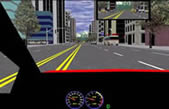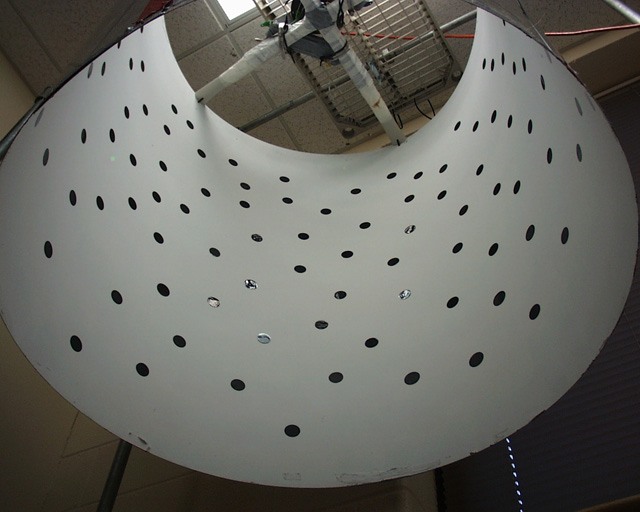UWF Human Factors Laboratory
The Human Factors Laboratory is under the direction of Dr. Steven Kass. In general, human factors research provides the knowledge to design systems that optimize human performance by compensating for human limitations and capitalizing on human strengths. Studies conducted in the laboratory have focused on attentional issues such as situation awareness, distraction, and tactile feedback and how they impact performance in driving and other psychomotor tasks.
Research Areas:

Spatial Abilities
Situation Awareness (slide presentation)
Situation awareness involves the ability to recognize, interpret, and integrate key patterns in the environment to accurately assess one’s current status and projection of future status. Good situation awareness allows one to react quickly in making crucial decisions. While situation awareness has been studied extensively in the military, this concept applies equally well to other environments such as driving and sports.
Haptic Responses to Visual-Spatial Stimuli (w/ NAWCTSD)
Due to verbal mediation, it is believed that perceptions that are often reported inaccurately, though the perception itself may be accurate. A more directly mapped response (psychomotor) may alleviate this problem. The idea is being tested for the task of submarine periscope operator.
Vibrotactile Displays for Spatial Awareness (w/ IHMC)
In situations where visual attention is diverted and/or under high cognitive workload, pilots may get spatially disoriented. A vibrotactile display is being tested to provide pilots spatial information through the relatively underutilized medium of tactile information.
Virtual Environments
Virtual environments (VE) and virtual reality are relatively new technological advances in training. Because of this, we currently know very little about their effectiveness or best use for training. One area of interest is to investigate mental maps of spaces visited only in VE transfer to the real spaces.

Sopite Syndrome
Sopite Syndrome Scale (w/ NAMRL)
Individuals experience different reactions to motion. Many people feel sick or nauseated while riding on a boat or amusement rides. However, motion may also lead to feelings of sleepiness (e.g., a baby rocking in a swing). This is called Sopite Syndrome and is a particularly dangerous reaction to motion for pilots. A scale is being developed to identify when someone may be experiencing the symptoms of Sopite Syndrome.
Human Factors and Aging
Attributing the Cause of Mishaps Involving the Elderly (UWF Small Grant)
According to Fundamental Attribution Error, when attributing the cause of an accident, observers are likely to overemphasize the impact of the characteristics of the person involved, rather than the circumstances surrounding the event. Though this is a common error, this may be particularly dangerous for some members of the population. For instance, if an elderly person is involved in a serious mishap with a piece of equipment, we are likely to overemphasize stereotypical aspects of the elderly, and dismiss the fact that the equipment may be inadequately designed for this portion of the user population.
Boredom
The Relationship between Boredom Proneness, Vigilance, and Attention Deficit Disorder
The ability to maintain attention for long periods of time (i.e., vigilance) is importance for performing many tasks, such as truck driver, assembly line worker, air traffic control, etc. Some individuals may be at a disadvantage for performing these types of task. For instance, vigilance tasks may be expected to be particularly difficult for individuals who are prone to boredom or have been diagnosed with attention deficit disorder (ADD). This study is examining whether vigilance performance can be predicted by scores on paper and pencil measures of boredom proneness and ADD.
Selected Research Articles:
Kass, S. J., Beede, K. E., & Vodanovich, S. J. (2010). Self-report measures of distractibility as correlates of simulated driving performance. Accident Analysis and Prevention. 42, 874-880.
Shanmugaratnam, S., Kass, S. J., & Arruda, J. E. (2010). Age differences in cognitive and psychomotor abilities and simulated driving. Accident Analysis and Prevention. 42, 802-808.
Allahyari, T., Saraji, G. N., Adl, J., Hosseini, M., Iravani, M., Younesian, M., & Kass, S. J., (2008). Cognitive failures, driving errors and driving accidents. International Journal of Occupational Safety & Ergonomics, 14, 149-158.
Kass, S. J., Cole, K. S., & Stanny, C. J. (2007). Effects of distraction and experience on situation awareness and simulated driving. Transportation Research Part F: Traffic Psychology and Behavior, 10, 321-329.
Beede, K. E. & Kass, S. J., (2006). Engrossed in conversation: The impact of cell phones on simulated driving performance. Accident Analysis and Prevention, 38, 415-421.
Vodanovich, S. J., Wallace, J. C., & Kass, S. J., (2005). A confirmatory approach to the factor structure of the Boredom Proneness Scale: Evidence for a two-factor short form. Journal of Personality Assessment, 85, 295-303.
Kass, S. J., Wallace, J. C., & Vodanovich, S. J. (2003). Boredom proneness and sleep disorders as predictors of adult attention deficit. Journal of Attention Disorders, 7, 83-91.
Rotunda, R. J., Kass, S. J., Sutton, M. A., & Leon, D. T. (2003). Internet use and misuse: Preliminary findings from a new assessment instrument. Behavior Modification, 27, 484-504.
Diamond, D. D., Kass, S. J., Andrasik, F., Raj, A. K., and Rupert, A. H. (2002). Vibrotactile cueing as a master caution system for visual monitoring. Human Factors and Aerospace Safety, 2, 339-354.
Hays-Thomas, R. & Kass, S. J. (2003). Integrating classroom knowledge and application through the Industrial-Organizational psychology internship. Teaching of Psychology, 30, 69-70.
Wallace, J. C., Kass, S. J., & Stanny, C. J. (2002). The cognitive failures questionnaire revisited: Dimensions and correlates. Journal of General Psychology, 129, 238-256.
Kass, S. J., Vodanovich, S. J., & Callender, A. (2001). State-trait boredom: Relationship to absenteeism, tenure, and job satisfaction. Journal of Business and Psychology, 16, 317-327.
Kass, S. J., Vodanovich, S. J., Stanny, C. J., & Taylor, T. M. (2001). Watching the clock: Boredom and vigilance performance. Perceptual and Motor Skills, 92, 969-976.
Wallace, J. C., Kass, S. J., & Stanny, C. (2001). Predicting performance in ‘Go’ situations: A new use for the cognitive failures questionnaire. North American Journal of Psychology, 3, 481-490.
Kass, S. J., & Ahlers, R. H. (1998). To VE or not to VE? A comparison of two VE technologies for training. Proceedings of the 42nd Annual Meeting of the Human Factors and Ergonomics Society, 1437-1441.
Kass, S. J., Ahlers, R. H., & Dugger, M. (1998). Eliminating gender differences through practice in an applied visual spatial task. Human Performance, 11, 437-449.
Raj, A. K., Kass, S. J., & Perry, J. F. (2000). Vibrotactile displays for improving spatial awareness. Proceedings of the International Ergonomics Association XIV Triennial Congress / 44th Annual Meeting of the Human Factors and Ergonomics Society (1), 181-184.
Kass, S. J., Hughes, S. C., Stanny, C., & Behan, B. (2000). Haptic reports of angle perception: A new twist. Proceedings of the International Ergonomics Association XIV Triennial Congress / 44th Annual Meeting of the Human Factors and Ergonomics Society (6), 120-123.
Kass, S. J., Herschler, D. A., & Companion, M. A. (1991). Training situational awareness through pattern recognition in a battlefield environment. Military Psychology, 3, 105-112.
Vodanovich, S. J., & Kass, S. J. (1990). A factor analytic study of the boredom proneness scale. Journal of Personality Assessment, 55, 115-123.




